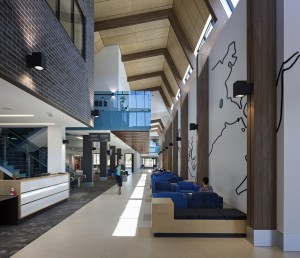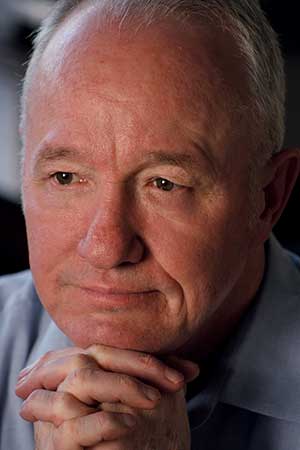Digital Business insights by John Sheridan >>
I NOTICED recently that somebody from Israel had read my earlier blog on regional change and I reread it myself. It is even more relevant today than it was last year.
So here it is again…with a few small changes:
The potential and opportunities presented by the tools of the digital revolution are enormous.
Most people are now regularly using digital tools – mobile phones, iPads, laptops, tablets and PCs. Connection is still the primary driver for change. Collaboration is increasing and integration is still embryonic.
The real connected up potential is something that only systems integrators think much about or experience first hand, and they are just starting to help their customers open up to a whole new realm of possibilities. 
But they can only go as far and as fast as their customers allow them.
The speed of change is dictated not by the vendors or by CIOs, but by the ability of CEOs to understand the possibilities and pursue them. And most CEOs are busy with other things.
Getting one CEO to see the potential is rare enough. Getting many to collaborate to do something is almost unheard of. So the big picture potential of multi-connectivity and collaboration is left untouched and unseen for now.
Almost by accident, Facebook and Linkedin are showing a glimpse of what might be. Even World of Warcraft and other online multi-user games demonstrate the ability of individuals that don’t know each other from anywhere on the planet to work together to complete a task. Open source software development is another example of worldwide collaboration. It’s happening, but task driven and usually short term.
Though adoption and use of social media tools is widespread, milking the value of collaboration has hardly begun.
And though “build and they will come” as a general principle isn’t true. Build something RELEVANT and USEFUL and they will come.
Value has to be defined. It is not just about money. Value has to be endorsed by all participants. Value has to be shared.
And that definition starts with the individual customer, not the vendor. It starts with a business and organisation, not government. It starts with the regions and jobs not with the NBN. It starts with the vision for a knowledge economy not just fibre to the home.
Driven by Google, the customer relationship has changed. Everyone thinks they understand that, but I’m not so sure. They think the customer relationship is the simple bit, and that the technology is hard. But it is the other way around.
For adoption isn’t compulsory. And people will pick up tools and use them how they decide, and when they decide. So beware. Understand all the players. There are lots of them. And understand the new rules.
If you can do that, the possibilities are practically endless.
We have created a whole society focused on short term, piecemeal, siloed operations. That made sense during the industrial revolution, but that approach blocks the true potential and possibilities of the digital revolution.
Most people now give little time to digesting their information properly. In this new complex, connected digital environment all is not what it seems.
It is possible to quickly grasp the how, and most young people are digital natives, extremely comfortable with the technology they pick up and use.
What they miss is what lies under the bonnet, the power inside the engine. Who owns it, who influences it, the agendas, the ambitions and the reality that digital tools are just another competitive environment that major corporations and governments recognise as important.
The older members of our society who saw the birth of digital have been around the block. They have seen recessions and depressions, wars and revolutions. They understand the power plays personally and every revolution is about power.
It is worth understanding the breadth of participants in this revolution as well as the dominant vendors like Apple, Google, Microsoft, IBM and others who get most of the media coverage. And that means reading a bit. Making the time to do it. Not thinking that doing research is a waste of time. Because not everything can be absorbed through the skin. Some issues have to be masticated and digested properly.
It is not good enough to think that somebody else in your organisation gets it. You have to get it. If you are the CEO, it is mandatory.
This revolution is changing the world. Whether it is for better or worse remains to be seen, but it is looking good at the moment.
As a species, we were never really comfortable with the industrial revolution anyway. We are social creatures, good at recognising patterns. We are programmed for collaboration. We appreciate sharing. We like to see things through.
In many ways the industrial revolution has devolved humanity, reduced our ability to see common unity and appreciate collaboration. For many people, our current dysfunctional society goes against the grain. It doesn’t feel quite right or good. It’s not about ideology it is about common sense and common experience. There is a lot of that around and we probably agree about more things than we disagree.
Australia is certainly not amongst the worst. It is amongst the best. But we can always do better. And that requires vision.
Short termism promotes selfishness. A siloed view of the world promotes nationalism. Short termism encourages people to opt out.
Short termism promotes the drive to waste, to use and abuse every resource regardless of long-term consequences. A siloed vision allows 1% of the population to own 99% of the wealth. It excuses it. It excludes comparison. It endorses huge bonuses and payouts.
Take a long term and bigger picture view and none of this makes sense. We are all connected and always were. The farmers and the factories and the exporters are all part of one chain. The city and the bush are connected in an eternal partnership. We need each other to be successful.
But unless we recognise what shared value means we will not get the participation and endorsement necessary to build regional capability and Australia’s productivity in a sustainable way.
In business, the customer is changing and has changed forever. The customer is influencing demand, aggregating demand. More importantly, the customer is choosing when to respond and when not to respond. When to buy and when not to buy.
Customers (people) have less time and more distractions, and reliability is even more important. Set and forget is the catchphrase. That requires trust. Short-term value is important, but long-term value is priceless.
Few businesses and corporations understand this background change.
Telstra Countrywide was a revolutionary initiative when it began, in tune with the digital revolution. In many ways, it was before its time.
In 2000, Telstra created a countrywide network of General Managers who lived and worked in regional centres across Australia. They understood the regions they lived in. They built relationships with local businesses, non-profits, schools and councils. They helped broker the benefits of the digital revolution for everybody and anybody.
They earned and gained trust. They built long-term business relationships. They created a platform for the regional digital economy. They would have been the natural regional trust-broker for the NBN, and most of the Regional Development Australia committees and councils across Australia.
But Mr Trujillo questioned the short term “business case”. And Telstra Countrywide, the most visionary, intelligent and strategic Telstra endeavour was done, and transformed back into a sales force, not a regional catalyst for positive change.
Because, what is the business case for a single business no matter how big it is, to manage countrywide, regional and long term trusted relationships?
There is a simple answer of course, but not an immediate answer, which is what Sol Trujillo was seeking.
The business case for building, countrywide regional trust is long-term business. Business “stickiness”.
The opportunity to trial and prove solutions in a regionally integrated pattern. To build new business on trust. The opportunity to trial and prove new business products and services. The opportunity to leverage the new NBN opportunity.
Telstra Countrywide was a visionary shared value project, a true 21st century division of Telstra that today is a shadow of what it used to be.
Customer value and shared value are the most difficult things to understand for most boards and financial controllers who only value the share price and next quarter bottom line.
To them the value is only the dollar, not the relationship that produces the dollar. Their decision reveals the lack of understanding of the digital revolution, the connection between the land and the crop, the customer and the dollar.
For without long-term vision and shared value customer relationship, ultimately there is no bottom line.
Because, the bottom line is only about price not value. And competing solely on price is a competition that can’t be won. The local, the agile, the trusted, the reliable and the loyal will win that battle every time.
Especially in a digital revolution.
Increased access to information means more light shines on any and every subject. Anything and everything can and will be discussed. Social media and forums provide the platforms for discussion.
The desire and demand for shared value is a natural bottom up response to the 19th and 20th century short-term, “I win – you lose” tactics of both commercial vendors and political dictators.
In the political sphere, where entrenched power can be supported and maintained by armies, tanks and weapons, the response to a request for shared value (political, social, religious or financial) is often brutal, difficult and complicated, as we continue to witness in Syria, Iraq, Israel and elsewhere.
It doesn’t matter that people involved in the Occupy movement don’t have a clearly articulated manifesto for change. They all agree on one thing.
Inequality, unemployment, corruption, corporation influence and greed are wrong. The slogan “we are the 99%” refers to the growing wealth gap between the rich 1% and the rest of the population.
It asks a question that has not been successfully answered. And we all know it.
The Occupy movement will not go away. It will evolve, reform and pop up again and again. It is a natural response to an unresolved condition. The power of electronic sharing and collaborative communication just provides the ability to marshal bottom up response like never before.
We are all connected. Personally, and through the multiple connections that are energised by collaborative and connecting media. Social media.
Win – lose is no longer the equation. Win-win-win is. Shared value is our destiny. Even Professor Porter from Harvard Business School recognises this. Command and control is threatened by the digital revolution and the genie will not go back into the bottle.
What does that mean for business or any organisation? Follow the new rules and success is possible. Flaunt them and failure is guaranteed.
Back to the bigger picture of the digital economy, the digital society, Australia and ultimately the world.
We have to collectively create the bigger picture by connecting all the pieces together. That sounds obvious, but it is not something we are good at. We have practised division for far too long.
Addition and multiplication is a different practice and requires a different vision. Connect up the right pieces and you can achieve a multiple effect. Is that about IT? Is that about applications? Is that about social media?
Of course, but it is really about vision. It means thinking beyond the borders of what we think we do. This evolution or revolution is uncomfortable for some, but exciting for many. We won’t see another one in our lifetime.
The edges are no longer clear. This article isn’t just about technology. Well duh. Technology isn’t about technology.
Technology is about tools. Tools are about people. Tools allow us to do things. And connected technologies are automatically going to lead us into territory where the traditional borders are absent or blurred. So we are all going to have to get used to it.
And start thinking in a more connected and inclusive way. Or it won’t work. And we won’t work.
In a regional sense that means inclusion of all the pieces of the jigsaw puzzle, not just social services, not just social services and government, not just social services and government and councils, but social services, government, councils, associations, businesses, individuals, households, lawyers, accountants, consultants, academia, media, IT services and support, and the rest. It all needs to be connected.
And it already is anyway. We can just use the power of technology to make it more effective and productive. It is happening already in many regions across Australia.
Mining companies can no longer ignore the big picture or the local picture. You can’t take resources from towns and regions without putting something back. Putting huge amounts of money into advertisements doesn’t really change the facts. Propaganda only works in the short term. There’s that short term thinking again. Mining companies like to think they are long-term thinkers with their 20-30 year projects, but compared to farmers they have only just begun.
Farmers, the best ones and that is the majority have always understood what the miners don’t. Everything is connected and you can’t steal from the farm what you then expect to sustain you for generations. Farmers add value to the soil. Year in and year out, or there is no farm. There is a message there.
We should listen harder to what Australian farmers have to teach us.
We need to add value in all our productive industries. We have the skills, the smarts and the willingness to achieve. We are good at team sports. We need to become good at team economic development.
We are not used to this. But this is where we have to go and this is what a society is supposed to be anyway. We must use the power of the technology that we now have to do what we have always dreamed of. Not just politicians, but all of us. We all dream.
We can no longer afford to continue to cut the branch we are sitting on. We never could. But in a world of 7 billion with limited water, air, food and resources, something has to change. We have to productively manage and farm the world we live in, not pillage it. It is about governance and management and stewardship and common sense.
For our part, here in Australia, we can do a lot. We don’t have to always check out what is happening elsewhere first and follow that. There is still a knee jerk tendency to think someone else, somewhere else knows better than us but it is not true. We can make our own decisions.
We need to support the innovation that is everywhere in Australia. It is a country full of innovation and ideas. Adding value and sharing value.
We need to share those stories. There are lots of them. Human beings learn from example. In becoming more capable and productive, we can demonstrate what could be, might be and should be, and in the process generate shared value, increase productivity and pride, improve fairness and capability across all parts of our society.
We can be the case study for what can be, not what might be.
We just need to document and publish the process. Demonstrate what will be and can be. New products and services will inevitably evolve from the process, new wealth and value. One and one will make two. Two and two will make four. But three and three will make nine, and four and four will make hundreds.
It is gardening not architecture. Our future lies in connecting the dots, internally, externally, working together collaboratively and effectively. And for the first time in our history, the technology gives us the means. We just need the collective will to do it.
- John Sheridan, September 2014.
*
John Sheridan is CEO of Digital Business insights, an organisation based in Brisbane, Australia, which focuses on helping businesses and communities adapt to, and flourish in, the new digital world. He is the author of Connecting the Dots and getting more out of the digital revolution. Digital Business insights has been researching and analysing the digital revolution for more than 12 years and has surveyed more than 50,000 businesses, conducting in-depth case study analysis on more than 350 organisations and digital entrepreneurs.
http://www.db-insights.com/


 How to resolve AdBlock issue?
How to resolve AdBlock issue? 




